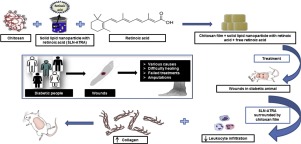当前位置:
X-MOL 学术
›
Colloids Surf. B Biointerfaces
›
论文详情
Our official English website, www.x-mol.net, welcomes your feedback! (Note: you will need to create a separate account there.)
Retinoic acid-loaded solid lipid nanoparticles surrounded by chitosan film support diabetic wound healing in in vivo study.
Colloids and Surfaces B: Biointerfaces ( IF 5.8 ) Pub Date : 2019-12-27 , DOI: 10.1016/j.colsurfb.2019.110749 Valquíria T Arantes 1 , André A G Faraco 1 , Frederico B Ferreira 1 , Cleida A Oliveira 2 , Elisângela Martins-Santos 2 , Puebla Cassini-Vieira 3 , Lucíola S Barcelos 3 , Lucas A M Ferreira 1 , Gisele A C Goulart 1
Colloids and Surfaces B: Biointerfaces ( IF 5.8 ) Pub Date : 2019-12-27 , DOI: 10.1016/j.colsurfb.2019.110749 Valquíria T Arantes 1 , André A G Faraco 1 , Frederico B Ferreira 1 , Cleida A Oliveira 2 , Elisângela Martins-Santos 2 , Puebla Cassini-Vieira 3 , Lucíola S Barcelos 3 , Lucas A M Ferreira 1 , Gisele A C Goulart 1
Affiliation

|
Repair of tissue damaged in diabetic wounds is essential to minimize the cases of amputation of the limbs in millions of diabetic people around the world. Although the all-trans retinoic acid (ATRA) is described as a potential wound healing agent, however its effects are controversial due to adverse reactions that may impair the wound healing during the treatment schedules. Our aim was to design and characterize an ATRA-loaded solid lipid nanoparticles surrounded by chitosan film to promote an ATRA controlled release and to evaluate its effectiveness in promoting wound healing in a diabetic mouse model. The SLN-ATRA were developed using biocompatible lipids without using organic solvent. The SLN-ATRA had high drug entrapment efficiency (98.0 %) and low polydispersity index (PDI) and average diameter, respectively, 0.24 ± 0.02 and 83.0 ± 6 nm. The transmission electron microscope (TEM) image presented that the SLN-ATRA were homogeneous in size and had spherical structures. The incorporation of SLN-ATRA in the chitosan films propitiated a homogeneous distribution of the drug and a controlled drug release. Furthermore, in vivo assay proved that chitosan films containing SLN-ATRA accelerated the closure of wounds of diabetic mice when compared to the control chitosan films without ATRA. SLN-ATRA chitosan films also reduced leukocyte infiltrate in the wound bed, improved collagen deposition, and reduced scar tissue. No sign of skin irritation was observed. These results indicated that SLN-ATRA surrounded in chitosan films are a promising candidate to treat diabetic wounds, improving tissue healing.
中文翻译:

在体内研究中,被壳聚糖膜包围的富含视黄酸的固体脂质纳米颗粒支持糖尿病伤口的愈合。
修复糖尿病伤口受损的组织对于最大限度地减少全球数百万糖尿病患者的肢体截肢病例至关重要。尽管全反式维甲酸(ATRA)被描述为潜在的伤口愈合剂,但是由于不良反应可能会损害治疗方案,因此其作用引起争议。我们的目的是设计和表征被壳聚糖膜包围的载有ATRA的固体脂质纳米颗粒,以促进ATRA控释并评估其在糖尿病小鼠模型中促进伤口愈合的有效性。SLN-ATRA是使用生物相容性脂质而不使用有机溶剂开发的。SLN-ATRA的药物截留效率高(98.0%),多分散指数(PDI)和平均直径低,分别为0.24±0.02和83.0±6 nm。透射电子显微镜(TEM)图像显示SLN-ATRA尺寸均匀且具有球形结构。在壳聚糖膜中掺入SLN-ATRA可以促进药物的均匀分布和受控的药物释放。此外,体内试验证明,与不含ATRA的对照壳聚糖膜相比,含SLN-ATRA的壳聚糖膜可加速糖尿病小鼠伤口的闭合。SLN-ATRA壳聚糖膜还减少了伤口床中的白细胞浸润,改善了胶原蛋白的沉积,并减少了疤痕组织。没有观察到皮肤刺激的迹象。这些结果表明,被壳聚糖薄膜包围的SLN-ATRA是治疗糖尿病伤口,改善组织愈合的有希望的候选者。
更新日期:2019-12-27
中文翻译:

在体内研究中,被壳聚糖膜包围的富含视黄酸的固体脂质纳米颗粒支持糖尿病伤口的愈合。
修复糖尿病伤口受损的组织对于最大限度地减少全球数百万糖尿病患者的肢体截肢病例至关重要。尽管全反式维甲酸(ATRA)被描述为潜在的伤口愈合剂,但是由于不良反应可能会损害治疗方案,因此其作用引起争议。我们的目的是设计和表征被壳聚糖膜包围的载有ATRA的固体脂质纳米颗粒,以促进ATRA控释并评估其在糖尿病小鼠模型中促进伤口愈合的有效性。SLN-ATRA是使用生物相容性脂质而不使用有机溶剂开发的。SLN-ATRA的药物截留效率高(98.0%),多分散指数(PDI)和平均直径低,分别为0.24±0.02和83.0±6 nm。透射电子显微镜(TEM)图像显示SLN-ATRA尺寸均匀且具有球形结构。在壳聚糖膜中掺入SLN-ATRA可以促进药物的均匀分布和受控的药物释放。此外,体内试验证明,与不含ATRA的对照壳聚糖膜相比,含SLN-ATRA的壳聚糖膜可加速糖尿病小鼠伤口的闭合。SLN-ATRA壳聚糖膜还减少了伤口床中的白细胞浸润,改善了胶原蛋白的沉积,并减少了疤痕组织。没有观察到皮肤刺激的迹象。这些结果表明,被壳聚糖薄膜包围的SLN-ATRA是治疗糖尿病伤口,改善组织愈合的有希望的候选者。



























 京公网安备 11010802027423号
京公网安备 11010802027423号